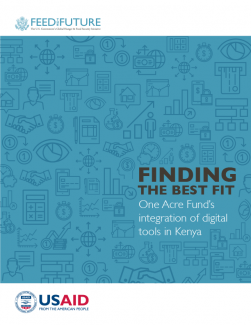One Acre Fund's integration of digital tools in Kenya
This case study is part of a series highlighting the integration of digital technologies into agricultural programs. Over the past ten years, and particularly over the past five, the use of mobile phones and Internet-based, digital tools in farming activities has sky-rocketed. This is largely due to the widespread adoption of mobile phones in developing and emerging markets, coupled with the increased spread of 3G and 4G connectivity. What has emerged is a broad set of digitally-based applications that have driven greater financial inclusion, more precision agriculture, better data collection and analytics, and more effective information dissemination. Agricultural organizations and programs are increasingly embracing these tools to advance their goals. Each case study in this series looks at different approaches to adoption and how the tools are impacting organizational culture, operations, and programming.
In 2006, One Acre Fund (OAF) began with a pilot in western Kenya to increase the profits 40 farm families earned from their fields by providing them with financing for high-quality agricultural inputs and nonagricultural products (Box 1). Over the subsequent ten years, the organization has grown to serve over 445,000 farmers across six countries in East and Southern Africa. In Kenya alone, the organization now serves more than 200,000 farmers. This growth had been made possible by a tireless focus on impact, measured via increased yields and farm profit; scale, with a focus on increasing the number of farmers served in each area; and financial sustainability for the organization. By 2020, OAF aims to serve at least one million farm families in Africa.
OAF’s ability to improve the lives of smallholder farmers at scale is enhanced by the integration of digital tools and services. The spread of mobile technologies and expansion of digital infrastructure allow agricultural investments to reach men and women farmers more efficiently and effectively, while empowering them to lead more productive and resilient lives. Digital tools reduce barriers and distance to markets, lower transaction costs, improve feedback and communication among actors, and enhance yields. They accelerate the achievement of agricultural development goals, such as Feed the Future’s goal of inclusive agricultural growth.
This case study tells the story of how digital tools are enabling OAF to accelerate achievement of its goals. It begins with an overview of the digital landscape in Kenya. Then it describes the organization’s overall approach to digital integration and specifically its experience integrating various digital tools and approaches in its operations in Kenya. It reviews the impact of digital tools on the organization’s operations and staff, and it offers lessons learned about its digital integration experience—drawn from the reflections of staff and clients.

